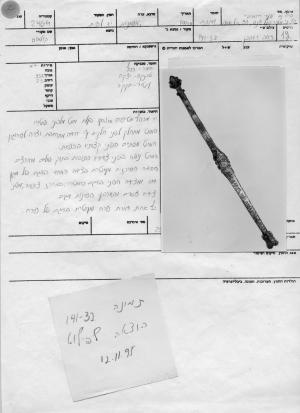Obj. ID: 20720
Sacred and Ritual Objects Torah pointer, Afghanistan, 1960

The Torah pointer is flat and consists of a bar and pointer. The straight bar bears an inscription on the upper and reverse sides. Engraved in outline letters, the inscription on the upper side reads:
זה הקולמוס שהקדיש יוסף באבאגאן בן בנימין ##גול לכבוד תורתנו הקדושה זיעא )זכותו יגן עלינו אמן(
"This is the Torah pointer which was dedicated by Joseph Babagan son of Benjamin Gol in honor of our holy Torah, may his virtue protect us, amen."
The inscription on the reverse side reads:
תורה צוה לנו משה מורשה קי')קהילת יעקב( )דברים לג ד( ח' סיון שנת תשך,
"Moses commanded us a law, even the inheritance of the congregation of Jacob (Deut. 33:4) 8th Sivan the year [5]720 (1960)." The bar is divided by an undulating middle joint, the upper side of which is decorated with a Star^of^David. Its reverse side is decorated with a bird flanked by stags, with a fish in each of the four corners. The bar is surmounted by an elongated upper joint, the reverse side of which is decorated with a fish. The pointer is flower-shaped and is also decorated with a flower. The entire Torah pointer is framed by a band with a recurring pattern of diagonal lines.
In Afghanistan, the pointer was called a qalam in the local dialects. It was originally a flat silver rod with one pointed end, but eventually, both ends became wider and were decorated with foliate or other designs. Gems were added to some pointers generally embedded as a part of the foliate patterns. The common method of decorating the Afghan Torah pointer was engraving. The favorite patterns were foliate and geometrical designs along the borders of the pointer, enclosing dedicatory or commemorative inscriptions. The inscription was engraved along the upper or back side of the pointer from the holding end to the pointing one. In the 1940s, when olive-wood Torah pointers from Eretz Israel reached Herat, the design of the Afghan pointer underwent some changes. These Israeli pointers were shaped like a hand with a pointing finger. They became extremely prestigious and were used only on the Sabbath and holy days. As a result, pointers made in Herat acquired a hand and a pointing finger.















